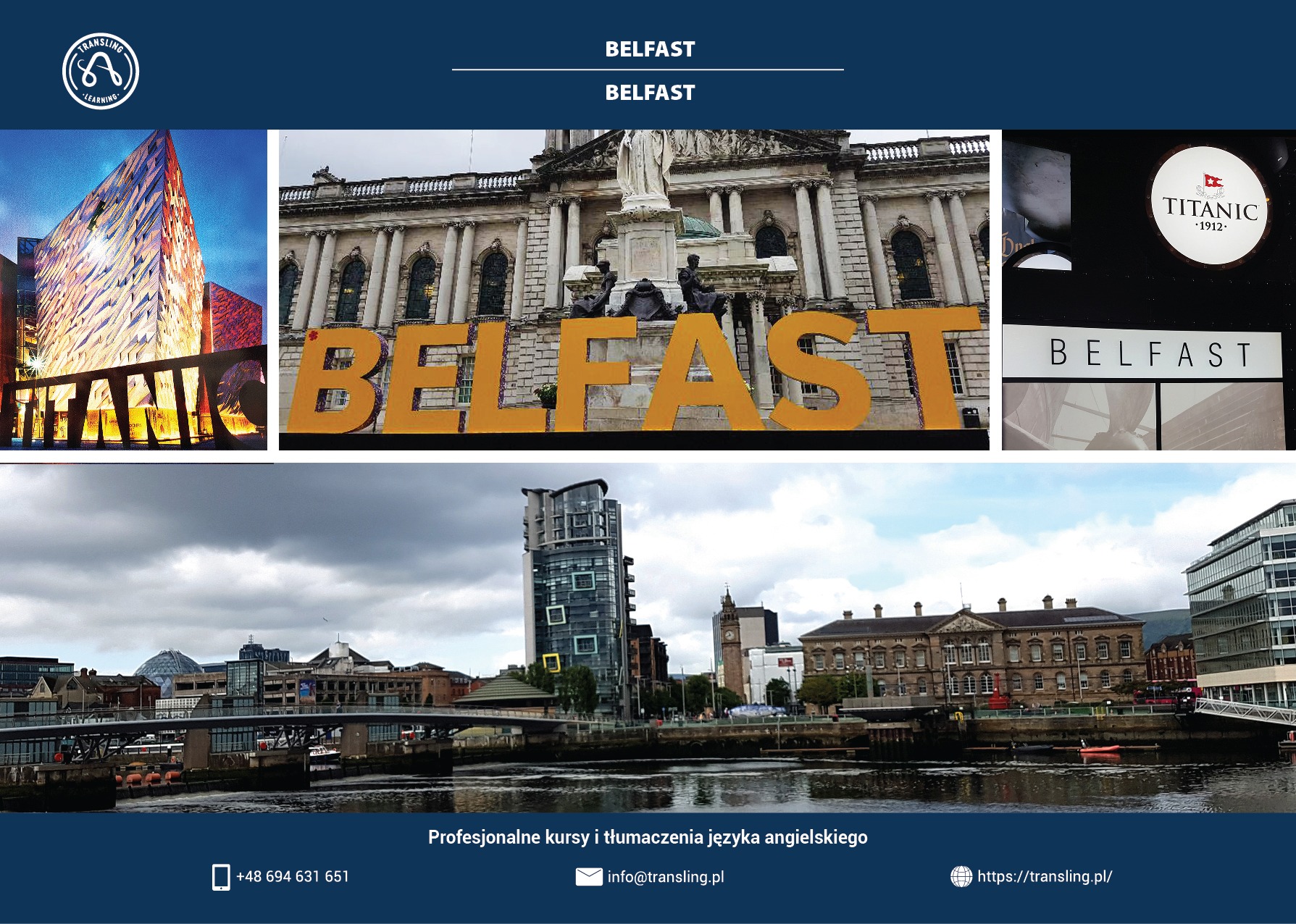Belfast




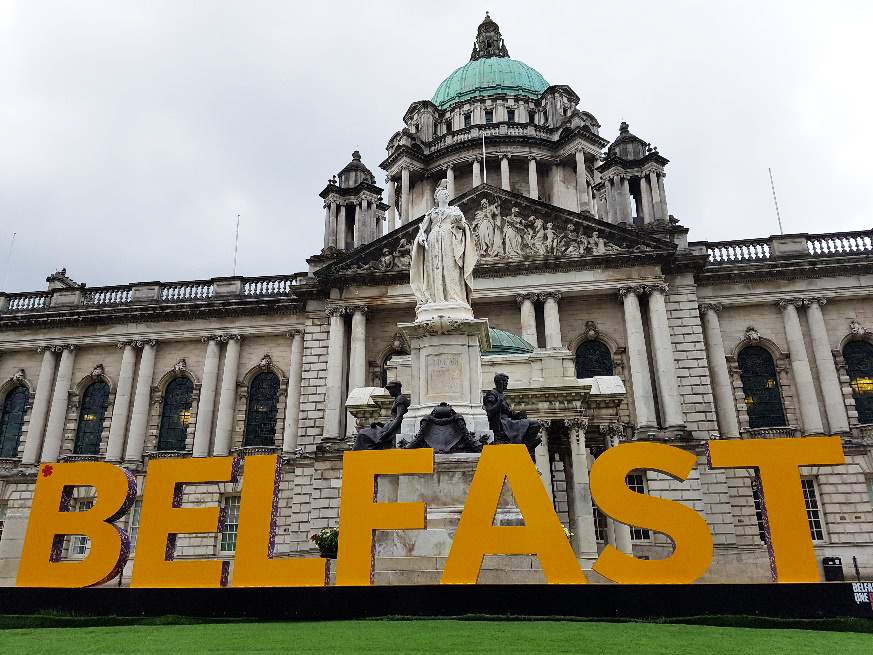
W tym miesiącu postanowiłam nawiązać do dwóch poprzednich postów i połączyć elementy Wielkiej Brytanii i Irlandii. Temat na sierpień to stolica Irlandii Północnej czyli części Zjednoczonego Królestwa a mianowicie Belfast.
Samo miasto jest niewielkie, ponieważ jego powierzchnia wynosi zaledwie 132,50 km², a liczba mieszkańców wynosi nieco ponad 340 tys. Można zatem pieszo przemierzyć najważniejsze i najbardziej charakterystyczne miejsca i obiekty znajdujące się w Belfaście w jeden weekend lub nawet cały jeden dzień. Podobnie jak Dublin, Belfast również odwiedziłam nie dawno, ponieważ pierwsza wycieczka miała miejsce rok temu a ostatnia w lipcu tego roku.
This month I decided to refer to the two previous posts and combine elements of Great Britain and Ireland. The topic for August is the capital of Northern Ireland, i.e. part of the United Kingdom, namely Belfast.
The city itself is small, because its area is only 132.50 km², and the number of inhabitants is just over 340 thousand. Therefore, you can walk through the most important and characteristic places and landmarks in Belfast within just one weekend or even one whole day. Like Dublin, I also visited Belfast not so long ago as the first trip took place last summer and the most recent one in July this year.
Na początek trochę historii
Irlandia Północna jako odrębny kraj powstała ponad wiek temu w 1921 r., gdy po utworzeniu Wolnego Państwa Irlandzkiego sześć z dziewięciu hrabstw prowincji Ulster pozostało przy Zjednoczonym Królestwie. W hrabstwach tych dominowali protestanci, większość z nich byli to potomkowie szkockich i angielskich osadników, którzy wyrażali sprzeciw zwierzchnictwu katolickiej Irlandii. To właśnie na tle religijno-społeczno-politycznym toczyły się konflikty w Irlandii Północnej, których początki sięgają już średniowiecza, kiedy to cała Irlandia znalazła się pod panowaniem Królestwa Anglii. Zasiedlanie Irlandii przez ludność angielską i szkocką rozpoczęło się w XVII wieku, a ziemie dla osadników zdobywano poprzez usuwanie z nich właścicieli irlandzkich. Jak można się było spodziewać zapoczątkowało to wrogość między Anglikami a Irlandczykami, jeszcze bardziej spotęgowaną różnicami religijnymi bowiem Irlandczycy byli katolikami, a nowi osadnicy głównie protestantami. W następstwie buntów i powstań, z których najbardziej krwawe miało miejsce w kwietniu 1916 – stąd nazwa Easter Rising, w 1921 r. doszło do utworzenia niepodległej Irlandii. W granicach Wielkiej Brytanii pozostała natomiast Irlandia Północna, którą w większości zamieszkują protestanci pochodzenia angielskiego. Walkę o połączenie z Irlandią prowadziła Irlandzka Armia Republikańska (IRA). W 1968 r. wybuchł krwawy konflikt w Irlandii Północnej zwany The Troubles pomiędzy republikanami dążącymi do zjednoczenia wyspy a unionistami, których celem było pozostanie w ścisłym związku z Wielką Brytanią. Po 30 latach konfliktu w 1998 r. zawarto wreszcie porozumienie pokojowe zwane wielkopiątkowym, a dwaj jego współtwórcy – John Hume i David Trimble – otrzymali pokojową nagrodę Nobla za pracę na rzecz pojednania między katolikami a protestantami w tej brytyjskiej prowincji.
A bit of history for a start
Northern Ireland as a separate country was established over a century ago in 1921, when, after the creation of the Irish Free State, six of the nine counties of the province of Ulster remained with the United Kingdom. These counties were dominated by Protestants, most of whom were descendants of Scottish and English settlers who were opposed to the authority of Catholic Ireland. It was against the religious, social and political background that the conflicts in Northern Ireland took place, the beginnings of which date back to the Middle Ages, when the entire territory of Ireland came under the rule of the Kingdom of England. The settlement of Ireland by the English and Scottish population began in the 17th century, and lands for settlers were acquired by removing Irish owners from them. As one might expect, this started hostility between the English and the Irish, even more intensified by religious differences, because the Irish were Catholics, and the new settlers were mainly Protestants. Following rebellions and uprisings, the bloodiest of which took place in April 1916 – hence the name Easter Rising, in 1921 an independent Ireland was created. Northern Ireland, mostly inhabited by Protestants of English origin, remained within the borders of Great Britain. The fight for unification with Ireland was led by the Irish Republican Army (IRA). In 1968, a bloody conflict broke out in Northern Ireland called The Troubles between republicans seeking to unite the island and unionists, whose goal was to remain in a close connection with Great Britain. After 30 years of conflict, a peace agreement called the Good Friday Agreement was finally concluded in 1998, and two of its co-authors – John Hume and David Trimble – received the Nobel Peace Prize for their work for reconciliation between Catholics and Protestants in this British province.
CO WARTO ZOBACZYĆ W BELFAST
WHAT IS THERE TO SEE IN BELFAST
Wycieczka piesza z portu do centrum
A walking tour from the docklands to the city centre
Niewątpliwie najważniejszym punktem dla odwiedzających stolicę Irlandii Północnej jest Muzeum Titanica nie tylko dla fanów jego historii czy filmu ale też dla tych, którzy niejako chcą odtworzyć pamięć i wiedzę z tamtych czasów. Dobrze zatem rozpocząć zwiedzanie od portu ze słynną stocznią Harland and Wolff, miejscem gdzie powstawał brytyjski słynny transatlantyk, liniowiec RMS Titanic. Nadal widoczne są elementy konstrukcyjne w tym charakterystyczny żółty dźwig (suwnica bramowa) H & W nawiązujący do nazwisk założycieli tj. Edwarda Harlanda i Gustava Wilhelma Wolffa.
Undoubtedly, the most important point for visitors to the capital of Northern Ireland is the Titanic Museum, not only for fans of its history or film, but also for those who want to somehow recreate the memory and knowledge of those times. It is therefore a good idea to start the tour from the port with the famous Harland and Wolff shipyard, the place where the famous British transatlantic, the RMS Titanic, was built. Construction elements are still visible, including the characteristic yellow crane (gantry crane) H & W referring to the names of the founders, i.e. Edward Harland and Gustav Wilhelm Wolff.

Nieopodal muzeum Titanica, po przeciwnej stronie, można napotkać kolejny okręt, stanowiący jednocześnie muzeum. Jest to SS Nomadic – jedyny zachowany statek z floty White Star Line, zwodowany w kwietniu 1911 r. w Belfaście, zbudowany do transportu pasażerów i poczty do i z liniowców oceanicznych RMS Olympic i RMS Titanic. Nomadic jest nazywany „małym Titanicem”, albowiem wiele jego detali było wykonanych przez tych samych pracowników, którzy budowali Titanica.
Near the Titanic museum, on the opposite side, you can encounter another ship, which is also a museum. It is the SS Nomadic – the only surviving ship from the White Star Line fleet, launched in April 1911 in Belfast, built to transport passengers and mail to and from the ocean liners RMS Olympic and RMS Titanic. Nomadic is called the „little Titanic” because many of its details were made by the same workers who built Titanic.
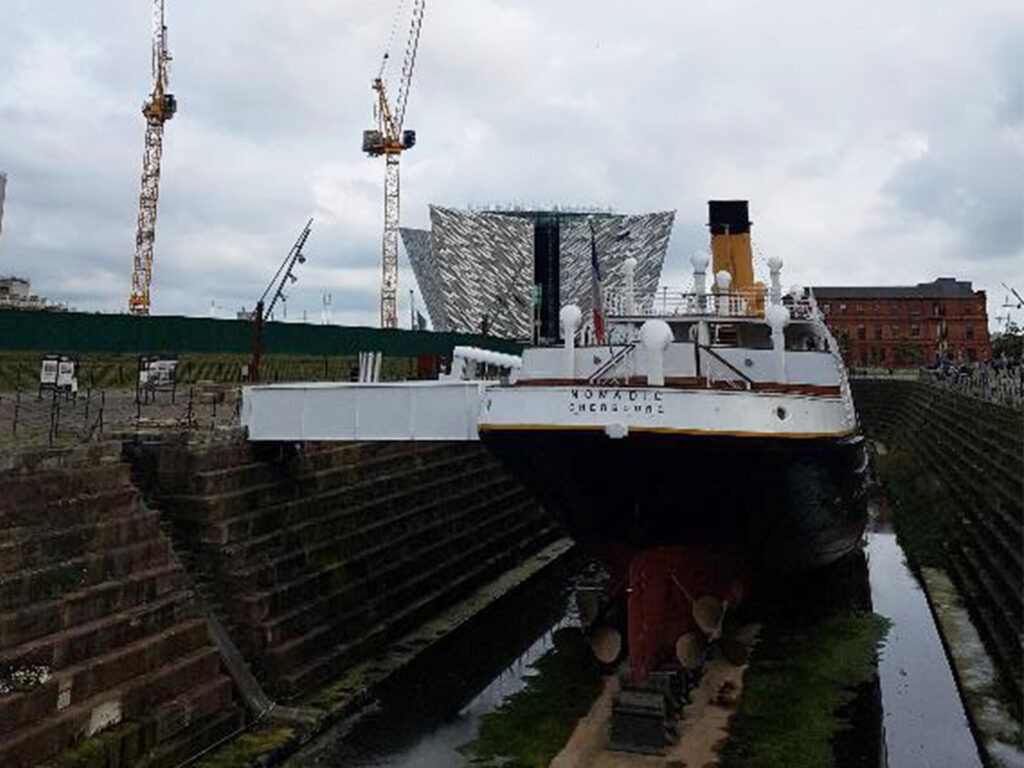
Idąc dalej wzdłuż portu w kierunku centrum można podziwiać panoramę miasta z charakterystyczną wieżą zegarową, podobną do londyńskiego Big Bena (więcej na ten temat nieco dalej).
Continuing along the docklands (port) towards the centre, you can admire the cityscape with its characteristic clock tower, similar to London’s Big Ben (more on this a little further on).

Kierując się na prawo przechodzimy przez most nad rzeką Lagan w kierunku centrum i tutaj warto zatrzymać się na chwilę bowiem po prawej stronie można podziwiać swoisty symbol miasta czyli wielką rybę o długości 10 m wykonaną z ceramiki, potocznie zwaną The Big Fish a oficjalnie The Salmon of Knowledge (czyli Łosoś Wiedzy). Jest to jedna z najbardziej obleganych atrakcji miasta.
Heading right we cross the bridge over the Lagan River towards the city centre and it is worth taking a break here for a moment because on the right side you can admire a kind of symbol of the city, a large 10 m long fish made of ceramic, commonly known as The Big Fish and officially The Salmon of Knowledge. It is one of the most popular attractions in the city.
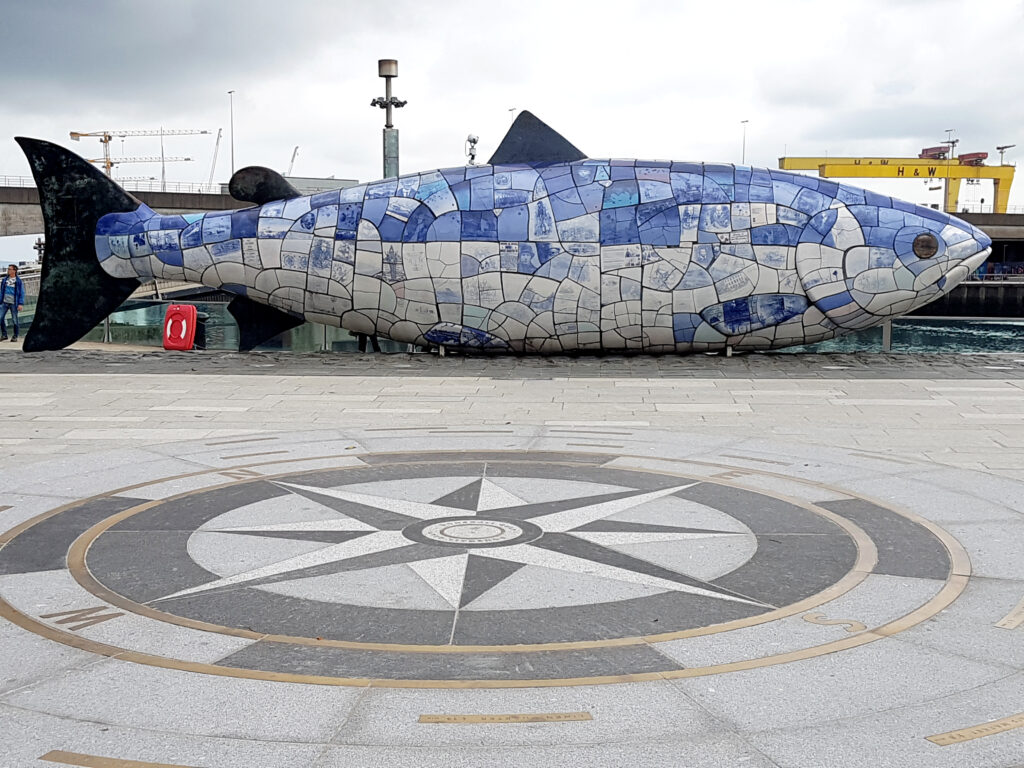
Przechodząc na światłach prosto zobaczymy charakterystyczną wieżę zegarową. Jest to Albert Memorial Clock, potocznie zwana Albert Clock, zbudowana na cześć księcia Alberta, męża Królowej Wiktorii. Wieża została ukończona w 1869 r. i stanowi jedną a najbardziej znanych budowli w mieście. Zegar ma podobną konstrukcję do Big Bena w Londynie. Wewnątrz wieży znajduje się dzwon ważący dwie tony. Jeśli chodzi o styl, jest on opisywany jako eklektyczna mieszanka wczesnego gotyku francuskiego i włoskiego. Po zachodniej stronie wieży, zwrócona w stronę High Street, stoi pełnowymiarowa statua księcia Alberta w szatach Rycerza Podwiązki, a wieżę otacza podstawa z łuków przyporowych zwieńczonych koronowanymi lwami trzymającymi tarcze i dekoracjami kwiatowymi. Cały obiekt jest czule nazywany „krzywą wieżą” miasta. Ma on 35 metrów wysokości i jest zbudowany głównie z piaskowca, został zbudowany na drewnianych palach odzyskanego, bagiennego terenu wokół rzeki Farset. Przez lata osiadanie fundamentów spowodowało, że zegar przyjął pochylenie 1,25 metra od pionu. Sytuacja ta doprowadziła do dowcipnych komentarzy, takich jak zegar Alberta „ma zarówno czas, jak i nachylenie”. W 2002 r. ukończono projekt renowacji, aby zatrzymać pogarszający się stan pochylenia i naprawić szkody spowodowane przez żywioł i duży ruch uliczny. Wzmocniono drewniane fundamenty, wymieniono niszczejące rzeźby i wyczyszczono cały budynek.
As you pass the traffic lights you will see the distinctive clock tower. This is the Albert Memorial Clock, commonly known as the Albert Clock, built in honour of Prince Albert, the husband of Queen Victoria. The tower was completed in 1869 and is one of the most famous structures in the city. The clock is similar in design to Big Ben in London. Inside the tower is a two tonne bell. In terms of style, it is described as an eclectic mix of early French and Italian Gothic. On the west side of the tower, facing the High Street, stands a full-size statue of Prince Albert in the robes of a Knight of the Garter, and the tower is surrounded by a base of flying buttresses topped with crowned lions holding shields and floral decorations. The whole structure is affectionately known as the city’s „leaning tower”. It is 35 metres high and constructed mainly of sandstone, built on wooden piles reclaimed from marshy land around the River Farset. Over the years, settling of the foundations caused the clock to lean 1.25 meters from the vertical, a situation that led to witty comments such as that the Albert clock “has both time and inclination.” In 2002, a renovation project was completed to halt the worsening lean and repair the damage caused by the elements and heavy traffic. The wooden foundations were reinforced, decaying carvings were replaced, and the entire building was cleaned.

I w ten sposób dochodzimy do samego centrum miasta, jesteśmy bowiem na High Street gdzie po obu stronach jezdni znajdziemy wszelkie obiekty handlowo-usługowe, restauracje, kawiarnie, mnóstwo sklepów, barów, pubów itd. Jednym z bardziej znanych pubów jest The Morning Star, założony w1810.
And in this way we reach the very heart of the city as we are on the High Street where on both sides of the road we will find all kinds of commercial and service facilities, lots of shops, bars, pubs etc. One of the more famous pubs is The Morning Star, founded in 1810.

Na skwerze pośród znanych sklepów, kawiarni i galerii handlowych można zobaczyć np. artystów ulicznych.
In the square, among famous shops, cafés and shopping centres, you can see, for example, street artists.

A po dłuższym spacerze wokół miasta można zrelaksować się przy 2 Royal Avenue w samym sercu miasta, w centrum społeczno-kulturowym gdzie znajduje się darmowa biblioteczka, kawiarenka oraz mnóstwo miejsca przeznaczonego na wszelkiego rodzaju spotkania czy odpoczynek.
And after a long walk around the city, you can relax at 2 Royal Avenue in the heart of the city, in the social and cultural hub which includes a free library, a cafe and plenty of space for all kinds of meetings or relaxation.
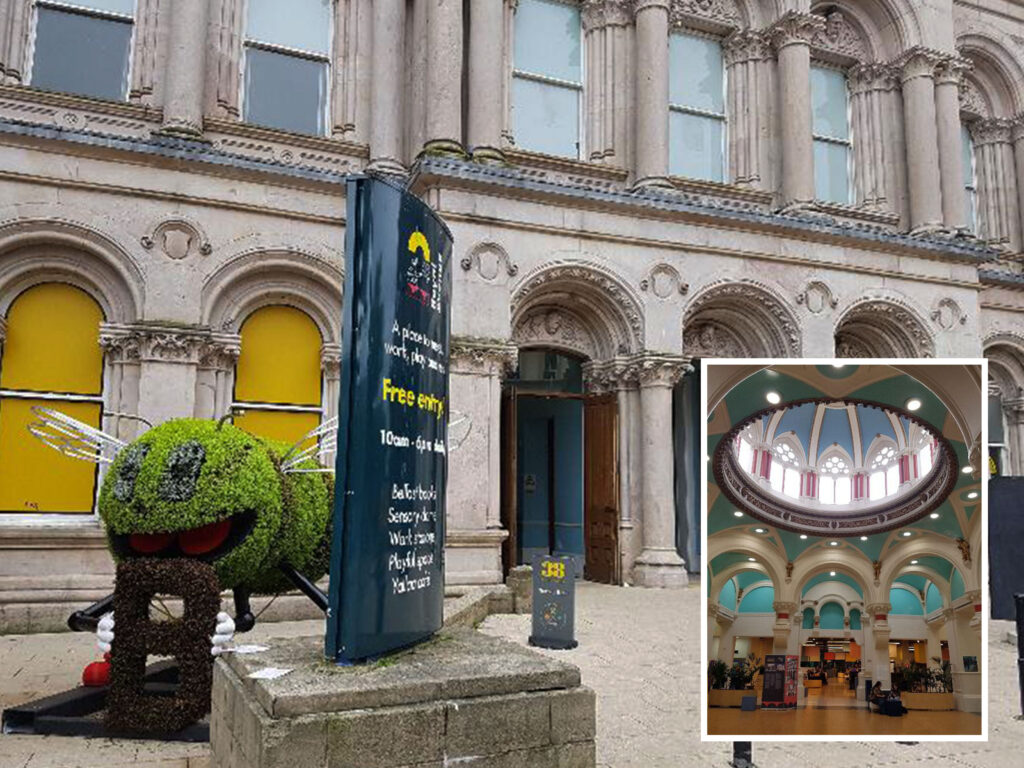
A przed nami ostatnie niemniej ważne miejsce na mapie Belfastu, znajdujące się na Donegall Square, bardzo znany obiekt czyli ratusz miejski (Belfast City Hall) z 1906 r. zaprojektowany w stylu barokowego odrodzenia, z detalami architektonicznymi i bogactwem dekoracji, jako symbol dobrobytu, który miasto przeżywało na przełomie XIX i XX wieku. To zdecydowanie jedno z najchętniej i najczęściej fotografowanych i odwiedzanych miejsc w Belfaście.
And last but not least important place on the map of Belfast, located on Donegall Square, a very famous building, namely the Belfast City Hall from 1906, designed in the Baroque Revival style, with architectural details and rich decorations, as a symbol of the prosperity that the city experienced at the turn of the 19th and 20th centuries. It is definitely one of the most popular and most frequently photographed and visited places in Belfast.

Będąc w okolicach ratusza warto podejść nieco dalej na Dogenall Street gdzie znajduje się Katedra w Belfaście czyli Belfast Cathedral lub St Anne’s Cathedral skonstruowana w stylu neoromańskim z okazałymi mozaikami, rzeźbami i witrażami. Kamień węgielny został położony w 1899 r. a budowa została ukończona w 1904 r.
When you are near the City Hall, it is worth walking a little further to Dogenall Street where you will find Belfast Cathedral or St Anne’s Cathedral constructed in the neo-Romanesque style with magnificent mosaics, sculptures and stained glass windows. The foundation stone was laid in 1899 and the building was completed in 1904.
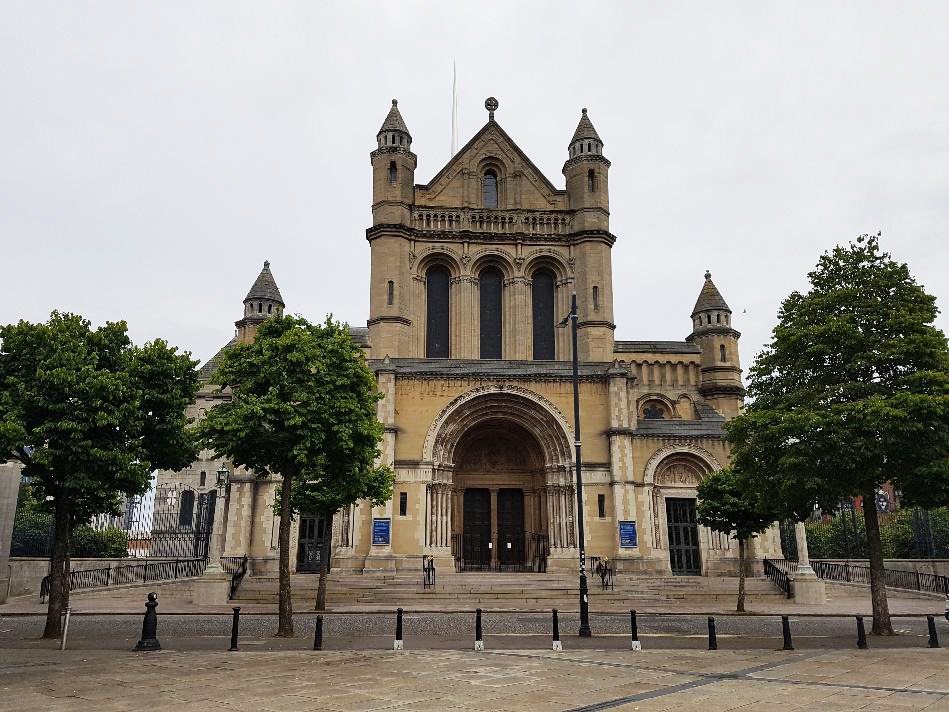
PODSUMOWANIE
Te wszystkie powyższe atrakcje można spokojnie przemierzyć pieszo w jeden dzień a kto ma więcej czasu można jeszcze udać się na zamek znajdujący się na zboczu góry Cavehill na wys. 120 m n.p.m.
Ciekawym punktem dla odwiedzających Belfast będą z pewnością wszelkie atrakcje przyrody poza miastem a takim najbardziej znanym miejscem jest z pewnością słynna Grobla Olbrzyma czyli Giant’s Causeway na samej północy kraju oddalona ok. 100 km od Belfast.
Niestety zarówno zamku jak i grobli nie miałam jeszcze okazji zobaczyć ale być może uda się uzupełnić te informacje w kolejnym roku.
SUMMARY
All of the above attractions can be easily covered on foot within one day, and if you have more time, you can also go to the castle located on the slope of Cavehill Mountain at an altitude of 120 m above sea level.
An interesting point for visitors to Belfast will certainly be all the natural attractions outside the city, and the most famous place is certainly the famous Giant’s Causeway in the very north of the country, approx. 100 km from Belfast.
Unfortunately, I have not had the opportunity to see both the castle and the causeway yet, but perhaps I will be able to catch up next year.

